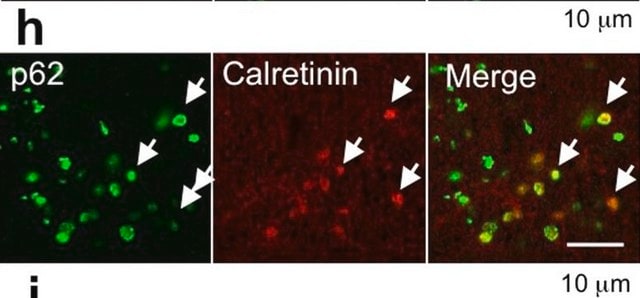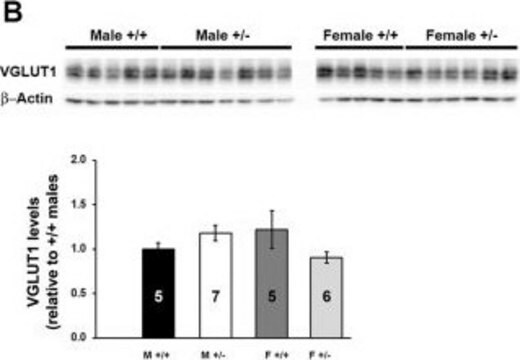추천 제품
생물학적 소스
rabbit
Quality Level
항체 형태
affinity isolated antibody
항체 생산 유형
primary antibodies
클론
polyclonal
정제법
affinity chromatography
종 반응성
hamster, mouse, human, guinea pig, monkey, gerbil, rat
제조업체/상표
Chemicon®
기술
immunocytochemistry: suitable
immunohistochemistry (formalin-fixed, paraffin-embedded sections): suitable
immunoprecipitation (IP): suitable
western blot: suitable
NCBI 수납 번호
UniProt 수납 번호
배송 상태
wet ice
타겟 번역 후 변형
unmodified
유전자 정보
human ... GRIA2(2891)
일반 설명
Glutamate receptors (GluRs) can be categorized as ionotropic or metabotropic and subcategorized by their agonist preferences (NMDA, AMPA or Kainic acid). There are four types of AMPA selective GluR subunits (GluR1, GluR2, GluR3 and GluR4). Tetrameric or pentameric combinations of different subunits contributes to the functional diversity of AMPA receptors. In general, AMPA receptors mediate fast synaptic current at most excitatory synapses, with stoichiometry characterized by subtype composition.
특이성
Expected to cross-react with human, rat, monkey, gerbil, guinea pig, and hamster.
It recognizes both GluR2 and GluR3 which have nearly identical carboxy terminal sequences. Western blot analysis of rat brain shows two poorly separated bands which comigrate with GluR2 and GluR3 expressed in transfected cells. GluR2 migrates slightly ahead of GluR3. No cross-reaction with GluR1 or GluR4. The antibody appears to recognize GluR 2 & 3 in several other species, but has not been extensively characterized in these cases.
면역원
Carboxy terminus peptide of rat GluR2 conjugated to BSA with glutaraldehyde (EGYNVYGIESVKI).
Epitope: C-terminus
애플리케이션
Immunohistochemistry:
A previous lot was used on paraformaldehyde or paraformaldehyde/glutaraldehyde fixed tissue with light and electron microscopy. Cryostat and vibratome sections can be used with or without Triton X-100 treatment. Final concentrations used were 1-3 µg/mL.
Immunoprecipitation:
When linked to immobilized Protein A, a previous lot of this antibody immunoprecipitated detergent-solubilized receptor from brain or transfected cells.
A previous lot was used on paraformaldehyde or paraformaldehyde/glutaraldehyde fixed tissue with light and electron microscopy. Cryostat and vibratome sections can be used with or without Triton X-100 treatment. Final concentrations used were 1-3 µg/mL.
Immunoprecipitation:
When linked to immobilized Protein A, a previous lot of this antibody immunoprecipitated detergent-solubilized receptor from brain or transfected cells.
Research Category
Neuroscience
Neuroscience
Research Sub Category
Neurotransmitters & Receptors
Neurotransmitters & Receptors
This Anti-Glutamate Receptor 2 & 3 Antibody is validated for use in IH(P), IC, IH, IP, WB for the detection of Glutamate Receptor 2 & 3.
품질
Evaluated by Western Blot on rat brain lysate.
Western Blot Analysis:
1:1000 dilution of this antibody detected glutamate receptor 2 & 3 on 10 μg of rat brain lysate.
Western Blot Analysis:
1:1000 dilution of this antibody detected glutamate receptor 2 & 3 on 10 μg of rat brain lysate.
표적 설명
108 kDa
물리적 형태
ImmunoAffinity Purified
Purified rabbit polyclonal serum lyophilized from buffer containing 0.01M phosphate, 0.09M NaCl, pH 7.2. 1% BSA and 0.1% sodium azide.
저장 및 안정성
Maintain lyophilized material at +2-8°C or -20°C for up to 6 months after date of receipt.
Reconstitute to 500 μL with sterile distilled water. Store reconstituted material frozen (-20°C or -80°C) in undiluted aliquots for up to six months. Diluted antibody containing 0.1% sodium azide for Western blot analysis can be stored for several weeks at +2-8°C and reused repeatedly.
Handling Recommendations: Upon first thaw, and prior to removing the cap, centrifuge the vial and gently mix the solution. Aliquot into microcentrifuge tubes and store at -20°C. Avoid repeated freeze/thaw cycles, which may damage IgG and affect product performance.
Reconstitute to 500 μL with sterile distilled water. Store reconstituted material frozen (-20°C or -80°C) in undiluted aliquots for up to six months. Diluted antibody containing 0.1% sodium azide for Western blot analysis can be stored for several weeks at +2-8°C and reused repeatedly.
Handling Recommendations: Upon first thaw, and prior to removing the cap, centrifuge the vial and gently mix the solution. Aliquot into microcentrifuge tubes and store at -20°C. Avoid repeated freeze/thaw cycles, which may damage IgG and affect product performance.
분석 메모
Control
Human brain tissue and extracts from mouse brain and rat brain tissue.
Human brain tissue and extracts from mouse brain and rat brain tissue.
법적 정보
CHEMICON is a registered trademark of Merck KGaA, Darmstadt, Germany
면책조항
Unless otherwise stated in our catalog or other company documentation accompanying the product(s), our products are intended for research use only and are not to be used for any other purpose, which includes but is not limited to, unauthorized commercial uses, in vitro diagnostic uses, ex vivo or in vivo therapeutic uses or any type of consumption or application to humans or animals.
Not finding the right product?
Try our 제품 선택기 도구.
신호어
Warning
유해 및 위험 성명서
Hazard Classifications
Acute Tox. 4 Dermal - Acute Tox. 4 Inhalation - Acute Tox. 4 Oral - Aquatic Chronic 3
Storage Class Code
13 - Non Combustible Solids
WGK
WGK 3
Flash Point (°F)
Not applicable
Flash Point (°C)
Not applicable
시험 성적서(COA)
제품의 로트/배치 번호를 입력하여 시험 성적서(COA)을 검색하십시오. 로트 및 배치 번호는 제품 라벨에 있는 ‘로트’ 또는 ‘배치’라는 용어 뒤에서 찾을 수 있습니다.
ZO-1 and the spatial organization of gap junctions and glutamate receptors in the outer plexiform layer of the mammalian retina.
Puller, C; de Sevilla Muller, LP; Janssen-Bienhold, U; Haverkamp, S
The Journal of Neuroscience null
Suleman Hussain et al.
Frontiers in molecular neuroscience, 9, 10-10 (2016-02-24)
Syntaxins are a family of membrane-integrated proteins that are instrumental in exocytosis of vesicles. Syntaxin-1 is an essential component of the presynaptic exocytotic fusion machinery in the brain and interacts with several other proteins. Syntaxin-1 forms a four-helical bundle complex
Eunice Y Yuen et al.
The Journal of physiology, 588(Pt 13), 2361-2371 (2010-05-06)
Cofilin, the major actin depolymerizing factor, modulates actin dynamics that contribute to spine morphology, synaptic transmission and plasticity. Much evidence implicates the cofilin inactivation kinase LIMK in synaptic function, but little is known about the cofilin activation phosphatase Slingshot in
Morgane Boillot et al.
Scientific reports, 6, 21769-21769 (2016-02-18)
The secreted leucine-rich glioma inactivated 1 (LGI1) protein is an important actor for human seizures of both genetic and autoimmune etiology: mutations in LGI1 cause inherited temporal lobe epilepsy, while LGI1 is involved in antibody-mediated encephalitis. Remarkably, Lgi1-deficient (Lgi1(-/-)) mice
Amanda L Jacob et al.
Hippocampus, 25(7), 798-812 (2014-12-20)
AMPA receptors are the principal mediators of excitatory synaptic transmission in the mammalian central nervous system. The subunit composition of these tetrameric receptors helps to define their functional properties, and may also influence the synaptic trafficking implicated in long-term synaptic
자사의 과학자팀은 생명 과학, 재료 과학, 화학 합성, 크로마토그래피, 분석 및 기타 많은 영역을 포함한 모든 과학 분야에 경험이 있습니다..
고객지원팀으로 연락바랍니다.









